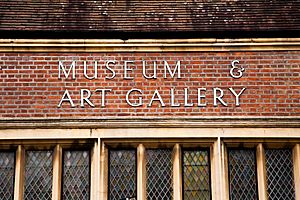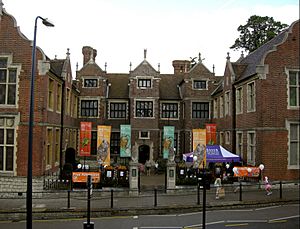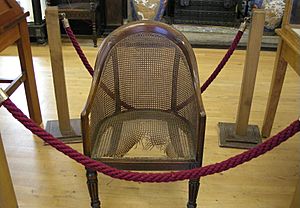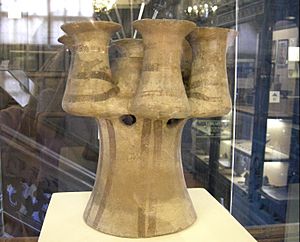Maidstone Museum facts for kids
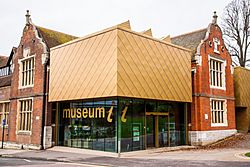 |
|
| Established | 1858 |
|---|---|
| Location | St Faiths Street, Maidstone, Kent, England ME14 1LH |
| Type | Regional museum, regimental museum, art gallery, heritage centre, historic house museum |
| Public transit access | Maidstone East railway station; Arriva Southern Counties |
Maidstone Museum is a super cool place in Maidstone, Kent, England. It's a museum run by the local council. Inside, you'll find amazing collections from all over the world. These include beautiful art, fascinating natural history, and stories about people from long ago. The museum building itself is very special, listed as Grade II*.
Contents
Discovering Maidstone Museum's History
The museum started thanks to a kind doctor named Thomas Charles. In 1855, he left his art and old treasures to the Maidstone Borough Council. He wanted them to create a museum called the Charles Museum. The Council bought his house, Chillington Manor, and opened the museum in 1858. It was later renamed Maidstone Museum. This museum was one of the first to open because of a special law called the Museums Act of 1845.
Exploring the Museum Building
The main part of the museum is an old Elizabethan manor house. It was finished in 1577 and was once called Chillington Manor. There are even older Tudor buildings behind it. In the early 1700s, a big new section was added to the west side.
After Thomas Charles passed away, the Maidstone Borough Council bought the building in 1856. They spent money to fix it up. On January 20, 1858, the museum opened its doors. It was one of the first museums in the UK run by a local council. Edward Petty, a friend of Thomas Charles, became the first curator. As the museum's collections grew, more parts were added to the building. A new east wing was built in 1869, and another west wing followed in 1873. These additions were made possible by donations from a famous explorer, Julius Brenchley.
Later, in 1889, the east side was extended again. This was to create the Bentlif Art Gallery. It was funded by Samuel Bentlif to show off the art collected by his brother, George. On the west side, the Victoria Gallery was built between 1897 and 1899. This gallery housed the town's library and celebrated Queen Victoria's Diamond Jubilee. The Bentlif Wing was made even bigger in 1923.
Amazing Collections at Maidstone Museum
Maidstone Museum has some of the biggest and most important collections in the south-east of England, outside of London. Over almost 150 years, collectors and staff have gathered more than 600,000 items! Three of these collections are super important for the whole country:
- Anglo-Saxon Treasures: This is the best collection of items from the richest Anglo-Saxon area in Britain.
- Japanese Art: One of the largest and most important Japanese collections outside of London.
- The Brenchley Collection: A huge and varied collection of items from all over the world. It includes things about different cultures, natural history, and beautiful art. This was all collected by the Victorian explorer, Julius Brenchley.
Human History: Stories from the Past
The Human History collections have about 125,000 items. The British archaeology collection covers Kent and other places. The internationally famous Anglo-Saxon collection has about 4,000 items from Kent. There are also items from other countries, like Gandhara heads and over 400 ancient Egyptian artifacts. The Egyptian collection even has the mummified remains of a woman named Ta-Kush. She was born in what is now Sudan and buried in Egypt over 2,600 years ago.
In 2009, the museum got a very special item: a Kernos from Melos in Greece. It's about 4,000 years old! There are only eight of these in the world. This one was probably used to hold offerings like honey and oats.
The local history collections tell many stories about life in Maidstone. You can see collections of weapons and armour, old clocks and watches, and over 18,000 coins and medals. There are also important collections of photographs and maps, plus over 10,000 printed items about Kent's history. The museum also owns the second volume of the Lambeth Bible. This is a giant, beautifully decorated bible from the 12th century.
The museum also has important collections of items from the Pacific, Oceanic, and African cultures. There are also diverse materials from Asia and North and South America. Did you know Napoleon's chair has been at the museum since 1866? He used to sit in it and even scratched it with his penknife while talking!
The Arts: Creativity and Beauty
The Fine and Applied Art collections have about 25,000 items. These include furniture from the 1600s to 1800s, musical instruments, toys, games, ceramics, glass, costumes, and needlework. You can also see paintings, prints, drawings, and sculpture. A favorite exhibit for local people is the Lady Godiva statue by John Thomas.
The ceramics collection is the most important in the region. It has about 700 English pieces and 250 European pieces. There's also a large collection of Chinese ceramics from the 1600s to 1800s. The museum has about 8,000 costumes dating from the 1600s to today. The needlework collections have about 700 items, including English embroidery and samplers, European embroideries, and Eastern textiles.
The Japanese collections of fine and decorative art are very important and studied a lot. They include ceramics, sword fittings, netsuke, lacquer, and books. There's also a series of over 750 Edo-period (1600–1868) woodblock prints.
The museum has 580 oil paintings, including some by old European masters and British artists from the 1800s and 1900s. The watercolour collection includes over 200 works by Albert Goodwin, which is the largest public collection of his art. There are also works by local artist James Jefferys.
Natural History: The World Around Us
The natural history section has about 450,000 specimens! Many of these are very important for national and international studies.
The bird collections include 1,800 mounted British specimens and 400 foreign birds. There are also over 1,100 cabinet skins. You can see 300 birds’ nests and a collection of bird's eggs from most British bird species. The Herbarium has about 30,000 plant specimens from the British Isles. There's also a British collection of about 6,000 specimens of important plant groups like Rubus, Taraxacum, and Hieracium. This Herbarium collection was used to create Philp's Atlas of the Kent Flora.
The entomology collection has about 250,000 specimens of British insects. There's also an important collection of several thousand shells. These are mainly from tropical oceans, but also include shells from temperate oceans, freshwater, and tropical land animals.
The collections of palaeontology (fossils) and vascular plants are very important for the country. They include special type specimens and ones that have been studied and pictured in books. The plant specimens include important ones for Kent and the nationally important Hawkweed (West) Collection. The fossil collection is strong in marine fossils from the Cretaceous and Tertiary periods in Kent. This includes fossils from Chalk, Lower Greensand, Lenham Beds, Gault, and London Clay. There's also a large collection of Pleistocene vertebrate fossils and fossils from the Kent Coalfield. The museum has 46,000 rocks and 7,000 minerals from all over the world. It has one of the most complete mineral collections in the country, outside of the national museums.
The Queen's Own Royal West Kent Regiment Museum
The Queen's Own Royal West Kent Regiment Museum is a special part of Maidstone Museum. It has been here since 1964 and is one of the museum's fifteen public galleries. This museum has over 3,000 medals, including four very brave Victoria Crosses!


